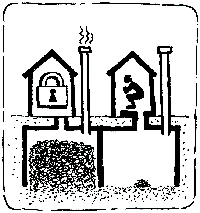
The Double VIP has almost the same design as the Single VIP with the added advantage of a second pit that allows the technology to be used continuously and allows for safer and easier emptying.
By using two pits, one pit can be used while the contents of the second pit rests, drains, reduces in volume, and degrades. When the second pit is almost full (the excreta is 50cm from the top of the pit), it is covered, and the contents of the first pit are removed. Due to the extended resting time (at least 1 year of filling/resting) the material within the pit should be sanitized and humus-like. The Double VIP is similar to the Fossa Alterna technology with the exception that the Fossa Alterna is specifically designed to produce humus and as such, it requires regular additions of soil, ash and/or leaves.
The superstructure may either extend over both holes or it may be designed to move from one pit to the other. In either case, the pit that is not being filled should be fully covered and sealed to prevent water, garbage and animals (and/or people) from falling into the pit. The ventilation of the two pits can be accomplished using one ventilation pipe moved back and forth between the pits or each pit can be equipped with its own dedicated pipe. The two pits in the Double VIP are continually used and should be well lined and supported to ensure longevity.
Advantages[edit | edit source]
- Longer life than Single VIP (indefinite if maintained).
- Potential for use of stored faecal material as soil conditioner.
- Flies and odours are significantly reduced (compared to non-ventilated pits).
- Does not require a constant source of water.
- Suitable for all types of user (sitters, squatters, washers and wipers).
- Can be built and repaired with locally available materials
- Can be used immediately after construction.
- Small land area required.
Disadvantages[edit | edit source]
- Low/moderate reduction in pathogens.
- Higher capital cost than Single VIP
- Reduced operating costs if self-emptied.
Adequacy[edit | edit source]
The Double VIP is more appropriate than the Single VIP for denser, peri-urban areas. The material is manually emptied (it is dug out, not pumped out), so vacuum truck access to the pits is not necessary. The users can remove the pit material after a sufficient resting time of one or more years even though the treatment processes in the pit are not complete and the material is not entirely hygienic. The Double VIP technology will only work properly if the two pits are used sequentially and not concurrently. Therefore, an adequate cover for the out of service pit is required. Double VIPs are especially appropriate when water is scarce and where there is a low groundwater table. They should be located in an area with a good breeze. They are not suited for rocky or compacted soils (that are difficult to dig) or for areas that flood frequently.
Health Aspects/Acceptance[edit | edit source]
The Double VIP can be a very clean, comfortable and well accepted sanitation option, in some cases even more so than a water-based technology. However some health concerns exist:
- Latrine leachate can contaminate groundwater;
- Pits are susceptible to failure/overflowing during floods; and
- Health risks from flies are not completely removed by ventilation.
Maintenance[edit | edit source]
To keep the Double VIP free of flies and odours, regular cleaning and maintenance is required. Dead flies, spider webs, dust and other debris should be removed from the ventilation screen to ensure a good flow of air. The out of service pit should be well sealed to reduce water infiltration and a proper alternating schedule must be maintained.
References[edit | edit source]
- Mara DD. (1984). The Design of Ventilated Improved Pit Latrines (UNDP Interreg. Project INT/81/047). The World Bank+ UNDP, Washington. (A good reference for detailed Double Pit VIP design information.)
- Mara, DD. (1996). Low-Cost Urban Sanitation. Wiley, Chichester, UK. (General description of VIPs with a focus on the ventilation system.) General Information:
- Franceys, R., Pickford, J. and Reed, R. (1992). A guide to the development of on-site sanitation. WHO, Geneva.
- Lewis, JW., et al. (1982). The Risk of Groundwater Pollution by on-site Sanitation in Developing Countries. International Reference Centre for Waste Disposal, Dübendorf, Switzerland. (Detailed study regarding the transport and die-off of microorganisms and implications for locating technologies.)
- The World Bank (1986). Information and Training for Low-Cost Water Supply and Sanitation (UNDP Project INT/82/002). The World Bank, Washington.
Acknowledgements[edit | edit source]
The material on this page was adapted from:
Tilley, E. et al. (2008). Compendium of Sanitation Systems and Technologies, published by Sandec, the Department of Water and Sanitation in Developing Countries of Eawag, the Swiss Federal Institute of Aquatic Science and Technology, Dübendorf, Switzerland.
The publication is available in English, French, and will be made available in Spanish. Available in the IRC Digital Library
Safety and risk[edit | edit source]
Stenström et al[1] suggest that a D-VIP is considered to be low frequency medium risk for both the user and the wider community. However, manually handling any feces waste is considered to be high risk.
For more discussion on this, see Infection risk from Ecosan